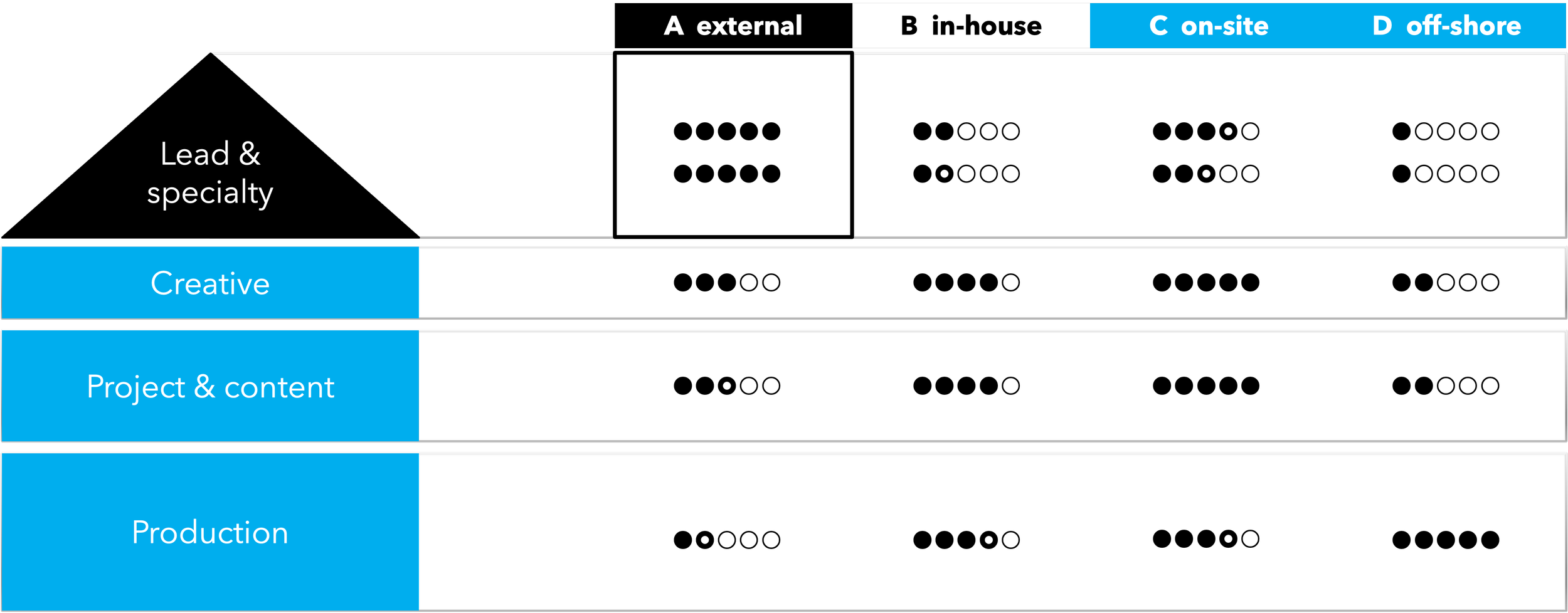The Flex Factor
– Adding flexibility in your marketing organisation
Remember when marketing plans were set in stone? Well, not anymore. We're in an era where being nimble is the new black. Gone are the days when a yearly marketing plan could be created, approved, and then executed without significant changes. In today’s ever-changing environment, flexibility and agility are not just desirable in marketing; they are essential. A marketing organization's ability to adapt quickly to market changes, consumer behaviour shifts, and technological advancements is a critical determinant of its success.
The ability to scale marketing teams up or down and add new competencies quickly is crucial. This need arises from various factors, including fluctuating market demands, seasonal trends, and the rapid evolution of marketing technologies and strategies. Businesses must be able to adjust their marketing team size efficiently to ensure that they are neither overstaffed during slow periods nor understaffed during peak times. Additionally, the introduction of new competencies, such as emerging digital marketing tools or data analytics skills, is essential to stay competitive.
The Rise of the On-Site Agency Model
The on-site agency model is a response to the limitations of traditional marketing structures. In the past, marketing departments often worked in isolation from other departments and external agencies. This siloed approach led to a lack of real-time communication and slow response times to market changes. The on-site agency model addresses these issues by placing a core team of marketing professionals directly within the client’s environment. This team works alongside the client, understanding their needs, culture, and objectives in real-time.
Advantages of In-House Marketing with an On-Site Twist
Deep Brand Understanding: Being physically present within the client’s environment allows the marketing team to develop a profound understanding of the brand’s values, voice, and audience. This in-depth knowledge leads to more accurate and effective marketing strategies that are closely aligned with the client’s vision.
Real-Time Collaboration and Communication: The proximity to the client ensures immediate communication and feedback, allowing for quicker adjustments and refinements in strategy. This real-time interaction is invaluable in a fast-paced market where timing can be a critical factor.
Agile Response to Market Changes: The on-site team can quickly respond to market changes, consumer trends, or competitive actions. This agility is a significant advantage over traditional models, where such responses might be delayed due to bureaucratic processes.
Financial Implications: The on-site agency model offers a strategic way to optimize marketing budgets. This blend allows for a more efficient allocation of funds, balancing the cost savings of internal resources with the specialized expertise of external agencies. Companies can thus leverage the strengths of both, ensuring that spending is focused where it's most effective, whether that's on internal innovation or external specialization.
Tapping into External Resources for Specialized Needs
While the core on-site team provides consistency and deep brand understanding, the flexibility of the model is further enhanced by its ability to tap into external resources as needed. This hybrid approach combines the best of both worlds – the stability of an in-house team with the dynamism and specialized skills of an external agency.
Access to Specialized Skills: Access to specialized skills in the on-site agency model is enhanced by the collaboration between the core in-house team and external experts. When specific expertise is needed, such as in digital marketing, data analytics, creative design, or content creation, specialists can be brought in seamlessly. This collaboration ensures that the organization has the right skills for particular projects, fostering innovation and high-quality outputs. The integration of these specialists with the in-house team allows for a synergistic exchange of ideas, further enriching the marketing initiatives.
Scalability: The on-site agency model offers significant scalability, allowing businesses to adjust their marketing team size as needed. This flexibility is crucial for cost-effectiveness and ensuring appropriate resource allocation during varying business cycles. During peak periods, the team can expand to meet increased demands, while in slower periods, it can scale down to maintain efficiency. This adaptability ensures that marketing strategies are not only cost-effective but are also precisely tailored to the business's current requirements, whether for intensive campaign efforts or routine brand maintenance.
Innovative Perspectives: External teams, through the on-site agency model, provide outside-in perspectives that can significantly enhance marketing strategies. Their fresh ideas and diverse approaches, often differing from those of an in-house team, can lead to more creative and impactful marketing solutions. This infusion of external viewpoints encourages a broader, more imaginative exploration of marketing possibilities.
In the 'On-Site model, also referred to as the 'In-House-Agency-as-a-Service' approach, external agencies play a pivotal role in both constructing and managing a company's in-house marketing operations. This collaborative model ensures the best of both worlds, with the expertise and flexibility of an external agency seamlessly integrated into the company's core functions. It's a strategic synergy that delivers heightened efficiency and impactful results.
Coupled with the 'On-Site' model, leveraging specialized and creative agencies for overall direction and creative concepts has been recognized as a winning strategy. According to a study conducted by the World Federation of Advertisers, this hybrid approach offers the best of both worlds. It allows companies to harness the focused expertise of specialized agencies for innovative, creative concepts, while the 'On-Site' model ensures seamless execution and integration. This synergy not only drives effectiveness but also enables companies to adapt swiftly to evolving market dynamics, positioning them at the forefront of their industries.
Leveraging Technology Efficiently
Navigating the myriad of MarTech options can be overwhelming. The hybrid agency model addresses this by providing a curated selection of MarTech and AI tools. This curated approach simplifies the implementation of marketing technologies, making the process more efficient and streamlined. It ensures that businesses can stay ahead in digital marketing trends without the complexities of choosing from an extensive range of technologies.
An on-site agency benefits significantly from utilizing MarTech across various in-house agencies. This approach leverages diverse technological tools, fostering a more integrated and sophisticated marketing strategy. It enables the agency to employ the most effective technologies from different in-house agencies, enhancing efficiency and productivity. The collective experience and knowledge gained from this cross-agency collaboration enrich the marketing solutions offered, making them more innovative and impactful.
Efficiency and Cost-Effectiveness
A major driver towards this model is the quest for efficiency and cost savings. In-house teams often find themselves mired in day-to-day operational tasks, which can stifle creative output. By implementing this model, companies can significantly enhance their operational efficiency, often seeing improvements of 30% to 40%. This boost in efficiency not only frees up time for creative endeavours but also streamlines overall marketing processes.
The model presents a balanced financial approach. It effectively mitigates the high fixed costs associated with maintaining an in-house team and the premium fees typically incurred from external agencies. This strategic financial balancing act has been shown to yield substantial cost savings, with some companies reporting up to a 40% reduction in expenses. These savings are not just a result of reduced expenditures but also stem from a more strategic and efficient allocation of resources, ensuring that every dollar spent on marketing delivers maximum value.
Embracing Flexibility for Future Success
The on-site agency model represents a significant change in the structure and function of marketing organizations. By combining the deep, contextual understanding of an in-house team with the flexibility and specialized expertise of an external agency, this model offers a solution that is well-suited to the demands of the modern business landscape. In an era where adaptability is key, marketing organizations that embrace this model will be better positioned to respond to market changes, innovate, and ultimately succeed.




